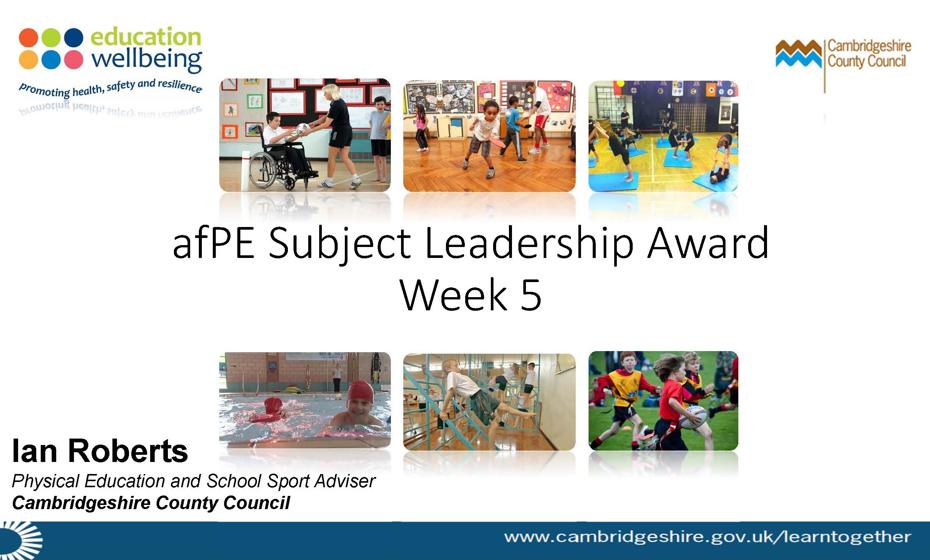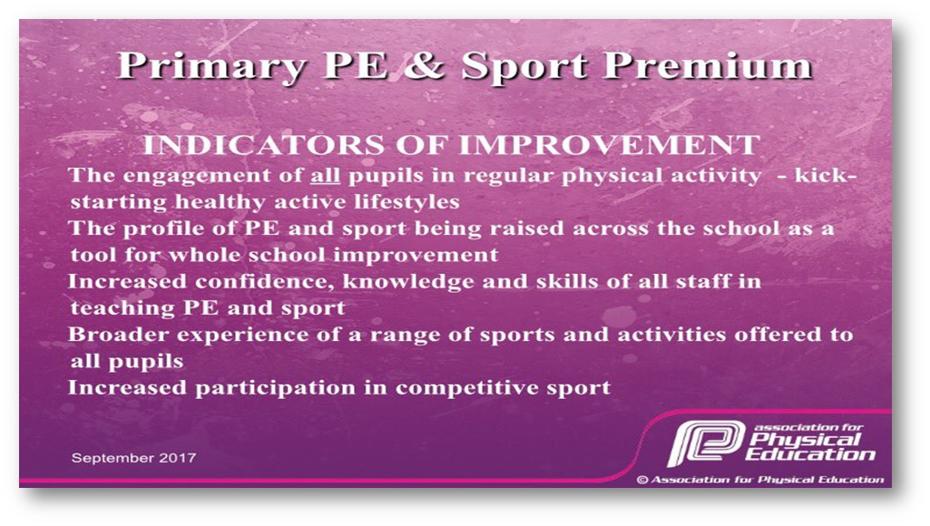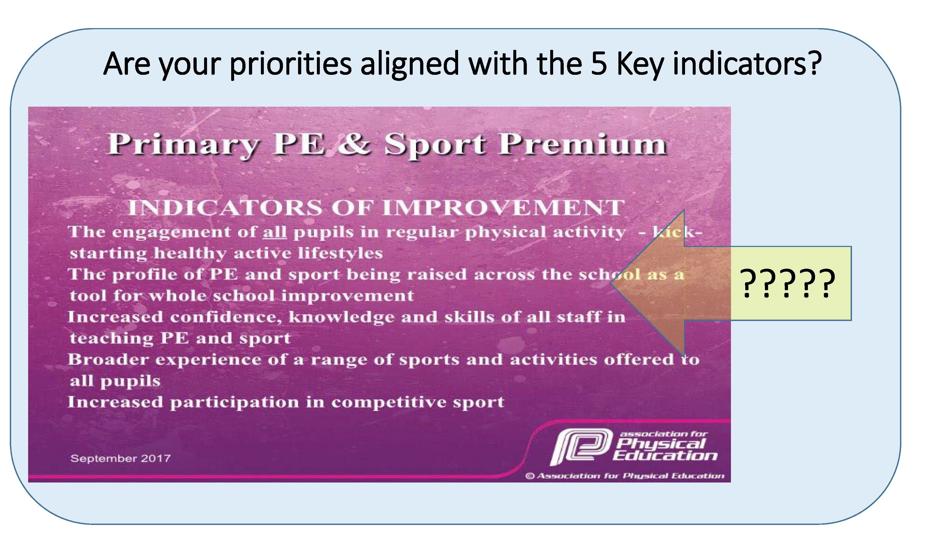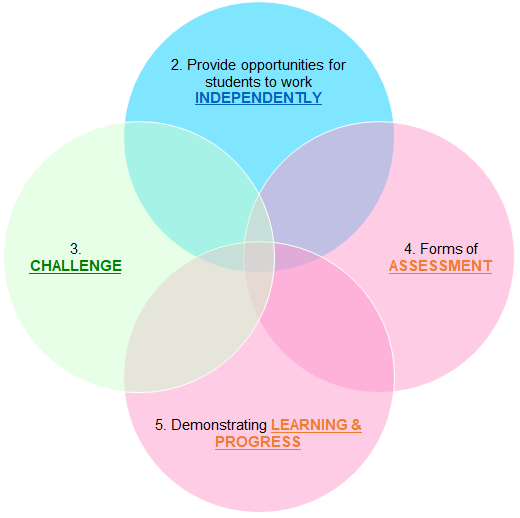
Reflective Activity
Consider the five Key Indicators that are used to determine the effective investment of the PE and School Sport Premium.

Reflective Activity
Consider whether your own school priorities align with the indicators. How, for example, could you raise the profile of PE and School Sport across the school as a tool for whole school improvement?

Reflective Activity
Think back to Task 1
- An audit of own existing abilities to be a primary school physical education specialist
- Creating a personal development plan from the findings of the audit
- Acting on the personal development to improve own abilities
- Reporting on progress against the personal development plan
- Review and revise the personal development plan to ensure that ongoing development
Reflective Activity
Consider the following chart.
How well do you measure up against each column?

Reflective Activity
Teacher personal skills and attributes
Consider the following attributes:
- Set high expectations which inspire, motivate and challenge pupils
- Promote good progress and outcomes by pupils
- Demonstrate good subject and curriculum knowledge
- Plan and teach well structured lessons
- Adapt teaching to respond to the strengths and needs of all pupils
- Make accurate and productive use of assessment
- Manage behaviour effectively to ensure a good and safe learning
environment - Fulfil wider professional responsibilities.
- Demonstrate consistently high standards of personal & professional conduct
What other attributes should teachers aspire to?
Personal development planning process
- What are the gaps in provision I need to address in order to meet pupil needs?
- What do I need to learn (skills and attributes linked to teachers’ standards) in order to meet pupil needs?
- What do I have to do in order to learn (formal / informal)?
- What support and resources will I need?
- How will I measure success?
- Review date
Summary: Personal Development Planning can help…
- Develop greater self-awareness
- Provide a sense of direction
- Improve course engagement
- Improve your motivation and effectiveness
- Develop greater resilience
Question
How do you currently provide pupils with ‘voice’ and ‘choice’?
Reflective Activity
- How important is lesson planning for teachers?
- Can planning be provided in lesson plan format?
- What are the risks and benefits of published lesson plans?
- What are you looking for when you review teachers' planning?
Create a list of things to look for and a set of four rules for providing support for planning.

Planning to Maximise Learning
“Planning is to teaching as writing music is to a symphonic performance. It’s analogous to the notes, the scales, the written plan that the musicians follow. Without written music, a symphony orchestra would be reduced to nothing more than discordant noise with no connection or purpose. Without a plan that focuses specifically on what pupils are expected to learn (not just do) in that lesson a teacher is simply keeping youngsters ‘busy, happy and good’.”
(Placek 1984)
Differentiating for learning
The process of changing tasks so that they match the ability of pupils and provide them with useful practice opportunities in a logical progression is often mis-interpreted. It’s easy to find or invent “stuff” that pupils will have fun with. All too often these experiences are a dead end because they don’t lead to improved motor performance.
An effective school is full of effective classrooms
“It matters much less which school a child attends than which classrooms they are in at school.” (Wiliam 2007)
Children fortunate enough to be in the most effective classrooms will learn in six months what students in an average classroom learn in a year
In the least effective classrooms it will take two years
What matters is the quality of the teaching

Reflective Activity
Choose an activity you included in your long term plan.
Plan a lesson or part of a lesson that includes:
- Independent learning
- Acquiring knowledge and/or skills
- Opportunities to explore or experiment with techniques, tactics, composition
- Leadership opportunities
- Physical activity
- Analysis of performance (AfL)
- Opportunities to evidence enrichment
- Some form of assessment!
The Challenge is:
- To get all students involved
- To tap into student curiosity
- To increase higher level thinking
- To prevent disengagement
The Five-Minute Lesson Plan

Reflective Activity
- What is Evaluation?
- Why do we Evaluate?
- How do we Evaluate?
Write a sentence / short paragraph demonstrating your understanding of each.
Assessment and Evaluation
- Assessment provides information about pupils progress towards the unit learning intentions and success criteria.
- The learning intentions are aligned to the standards
- Results of assessment are used to plan our teaching and content to meet pupil learning needs from lesson to lesson, unit to unit, year to year, key stage to key stage
- This link between planning, teaching and assessment should be robust
- Evaluation uses our assessment information and evidence to make informed decisions about ‘what next’
- Evidence should exist to support our key judgments
Evaluation, evidence and reflection

There is always the possibility that what we think is a successful lesson or series of lessons is different to the view of someone observing
Consider evaluation as
'Intended versus achieved learning'
Reflection
How do we bridge the gap?
Honest and inclusive evaluation can prevent gaps in our provision from turning into pupil disappointment.
Viewed in this way evaluation serves as an essential driver for identifying professional development.


